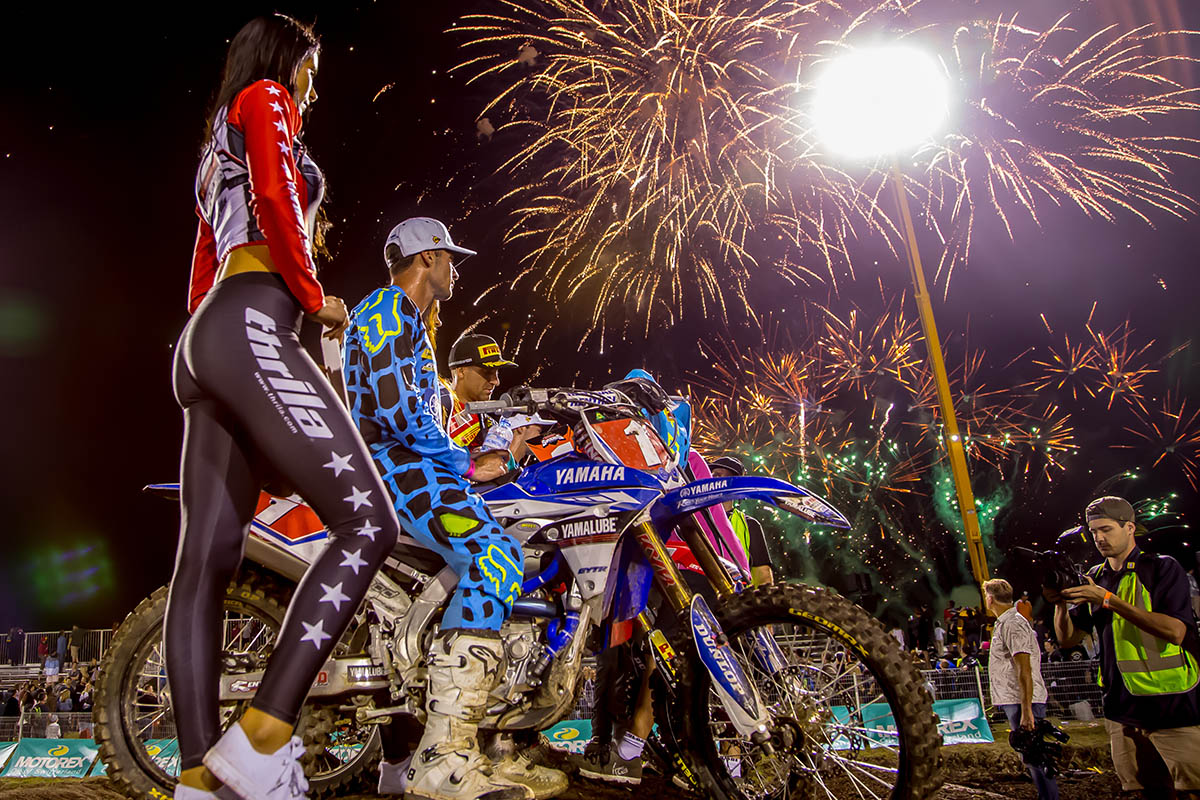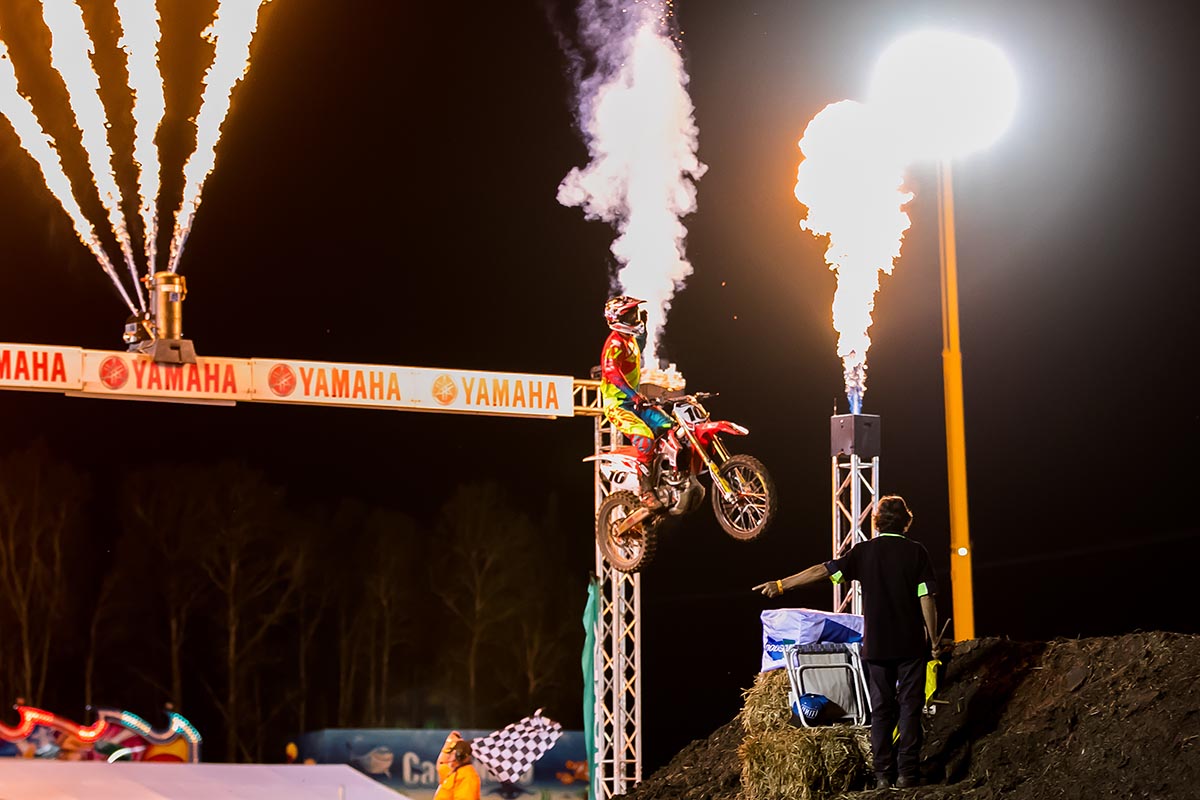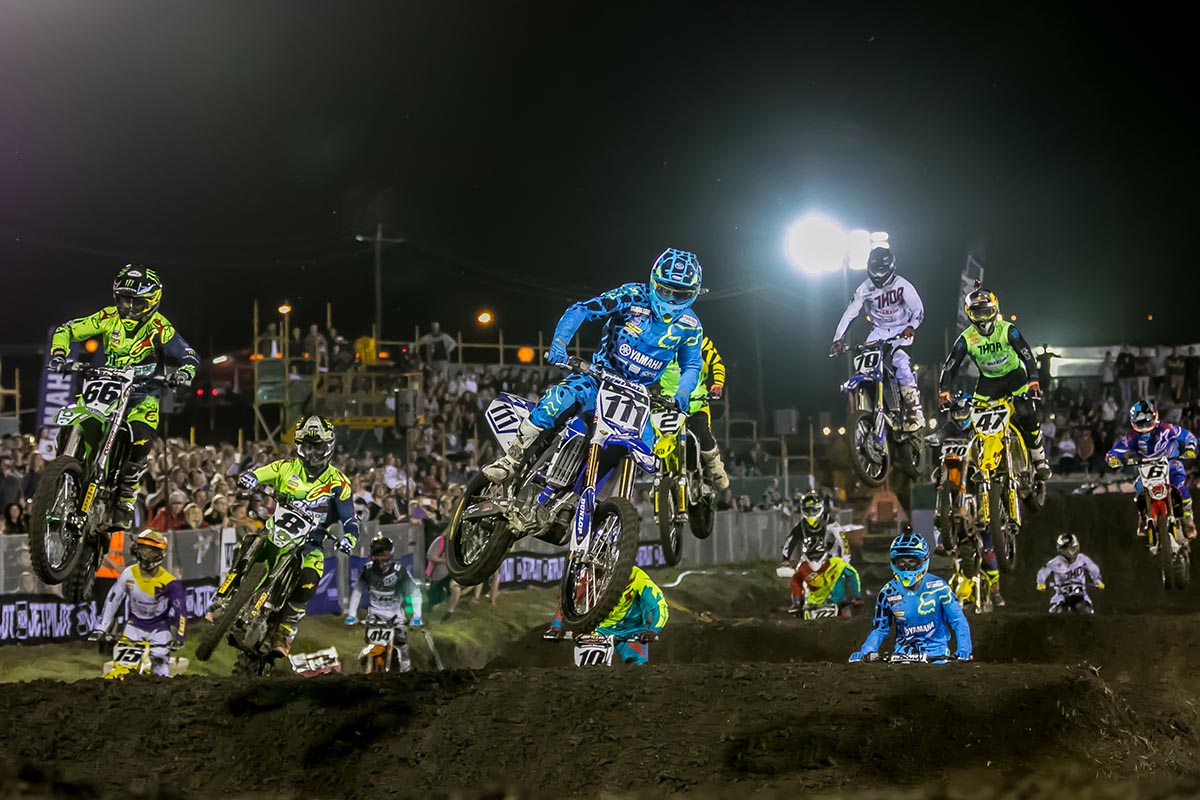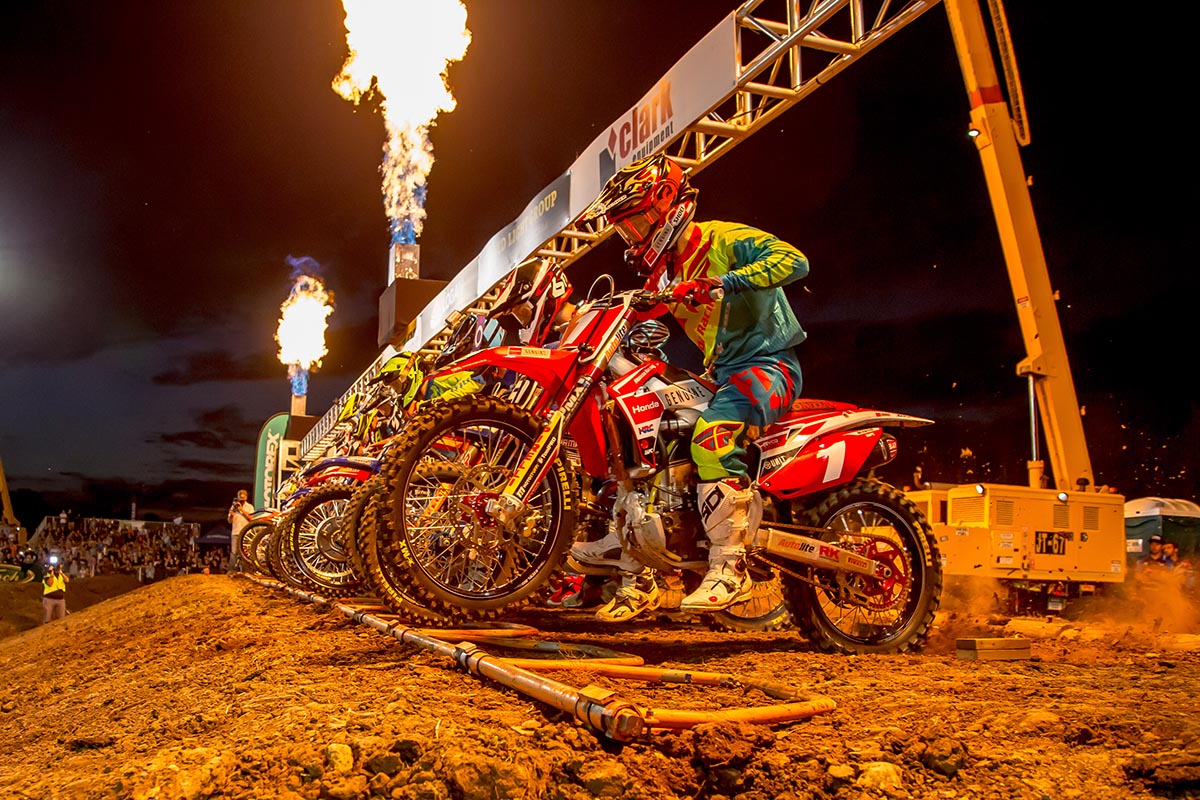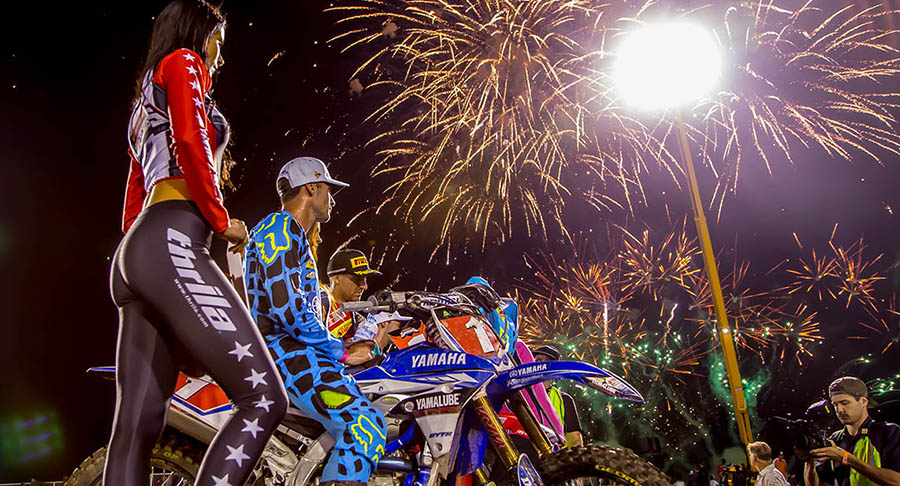
Scott Bannan brings a fighter’s mentality to race promotion — literally — and supercross is benefiting
WORDS & PICS AARYN MINERDS
Scott, how do you go from professional fighter to race promoter?
I started out playing professional football on the Gold Coast and like every kid I suppose I did something in the off-season to get fitter and got into kickboxing and really enjoyed it. I ended up throwing the football away and focusing on the fighting and had 67 fights for 60 wins with a total of 12 titles, including three world titles.
Looking back, the fight scene was a bit like supercross in Australia. When I first started the fights were big events and the promoters really looked after the fighters. Then for a while there were some dodgy promoters around and I’m the type of guy who can’t sit back and watch that, so we started promoting our own shows.
We’ve been promoting fights for almost 20 years and we were getting a little tired with it. At the same time I was riding a lot of moto at home [with] the likes of Gibbs and Harrison who was the rider who got me involved with the sport. Hanging out with Harry, I could see how everything was working and again I didn’t want to sit back and watch it being done poorly. I’d rather have a crack at doing it myself than just sit back and whinge about and just be all talk, like you see a lot of on the internet these days. And it all kicked off from there.
Peter Doyle, as both the MA sports director and now Motorcycling Australia’s chief executive officer, he has been really good. He’s been there as a team manager and been around the sport a long time. He’s the real deal and not some pen pusher sitting in an office. We speak to him a couple of times a week and MA have been really good to work with as they oversee and administer the whole championship.
Why take on the role as a supercross promoter when so many have struggled before you in recent times?
I’d been going to a lot of races, both motocross and supercross, with Brendan Harrison and it blew me away how the riders were getting treated. The lack of prize money and how dear the entry fees were for riders, ridiculous fines — I couldn’t believe how things were happening compared to how fighters are treated.
I can tell you, I’ve done both and fighting is a lot easier than riding a bike and a lot less dangerous. Then, to watch the show the guys out there put on to get paid nothing back in prize money, we just knew we could do a better job. So we put our hat in the ring and grabbed it and have gone about pushing for the riders to be treated better.
Over the past couple of years you’ve been able to reduce round entry fees from what they were and at the same time increase prize money. It must be rewarding to see it starting to swing around in favour of the riders.
It’s been great, not only to be able to do it ourselves but also [to] have the other promoters of the other supercross rounds jump on board and back that decision and support us — that really has been the key. We are now at $200,000 in prize money, which is a lot more prize money than any series has seen in Australia for a long time, and our round entry price has dropped again, especially for the junior riders. We’ve been able to reduce entry price for the Queensland, Victorian and South Australian rounds down to $200 for all senior riders and $50 for juniors.
In addition, it looks as though the Junior 85cc class and the Junior Lites class will both receive official Australian Championship status this year, which we’ll hopefully confirm before the series kicks off. We want to keep pushing, though; we want to be able to give back to the riders more and more each year and keep pushing that envelope. The industry has been a little slow at first to get on board and support us but, now we’ve been around for a few years, they understand that we’re here to stay.
Looking back, how would you evaluate your first couple of years as a SX promoter?
Promoting the series has been good — it’s been a lot of hard work but we’re still very passionate about it. Toowoomba last year certainly wasn’t a money earner for us but the show we were able to put on and the track we provided was still first rate and we learned a lot from going there, but it’s not something we’ll do again.
Jimboomba for us is a no-brainer: it’s always sold out from pretty much the moment we put tickets on sale, so we’ll go back to having J1 and J2 but this year have those rounds bookend the series with the opening and final round to be held there. It will also give us the opportunity to do a good job on closing the championship out.
We are going to have a big event on the Sunday after the final round where everyone involved in the championship can celebrate the series — something for not only the riders but also all the teams and their crews, their truck drivers and everyone involved in the series, can sit back and reflect on the championship.
Riders need to help themselves as well.
The riders themselves also need to stand up a little more — to get out there and race for free to me seems a little crazy. I know there are guys out there that are desperate to race but they need to get together and form some type of group and look out for each other.
It costs over $2000 in riding gear just to get dressed to get out on track, let alone the cost of the bikes, parts, travel, then add on top of that paying an entry fee to put on the show when the majority of the riders out there aren’t getting paid. It’s one of the big reasons why we’ve not only been vocal about pushing prize money right through the field but are continuing to increase prize money all the way through the field, giving the privateers a chance to earn some money as well. The riders have told me themselves that entry fees and prizemoney are the some of their biggest concerns and so I’ve responded.
The first couple of years, the other promoters wanted to keep going down the same old path of not paying the riders much prize money, but with the new promoters on board they see the benefit of paying the riders further down the field and it’s good to be working with a group of promoters that are all backing each other.
Over recent times, unless you were a factory backed-rider, no one out there was making any money from the races. It’s is something we’re working hard at changing and are getting closer to each year. We need the privateer riders out there; without them we’re just killing the sport.
What are some of the things you’ve been working on with the other promoters for the 2017 season?
We had a meeting with all the promoters at the start of the year. Our round prize money last year was more than everyone else’s, so we all got together and were able to get everyone to lift their prize money up to the same level as the two Queensland rounds so there’s more prize money across the board again for the 2017 championship.
We were also able to get all the entry fees reduced again for this season. Off the top of my head, we’re down to $200 for a senior entry and $50 for the junior classes and we’ve been able to scrap the medical levy for the Queensland, Victorian and South Australian rounds, which saves riders more money again. The plan for our two rounds this year is to have two good tracks at a venue we know works and people will flock to.
What can we expect to see at the two Queensland rounds in 2017?
We will have two all-new tracks for each of the races at Jimboomba, something completely different {from] what we saw last year. We’re working on a TV deal now, so we’re looking at being back on TV again for both of our races.
Last year we spent a lot of money bringing out international riders. As a promoter we won’t be doing that again this year with our events. I don’t want to be spending hundreds of thousands dollars on bringing American riders out; we sell Jimboomba out regardless so I’d rather put that money back into our local riders. It’s great to have the international riders out here but I want to build the Aussie guys up as superstars in their own right. That’s what we’re planning on doing again this year.
We really want to promote the juniors again this year. Watching the three 85 rides at the front of the field jumping the triple and most of the sections the pro riders were jumping was great to see and it’s something we really want to highlight again this year. They’re the future of the sport. In America everyone knows who the next big amateur kid is coming through the ranks — we want to get back to having the junior riders being known in Australia before they turn senior.
We also have two practice days, one in July and one in August, then on the Sunday after the opening supercross we’re going to run an Arenacross, just for the amateurs and the juniors. The plan is to mellow off the whoops and take out the triples and give the amateur guys a chance to ride a tamed-down national-level supercross track, and also the junior riders, without the worry of having the pro riders on the track. There’ll be no prize money or anything like that, just a chance for riders to experience the track.
We know the on-track action will be great but can you give us any inside info on what we can expect in terms of entertainment off the track?
Ha-ha! Nah, we’re keeping that to ourselves for now. We have some big things in store and I can guarantee we’ll be putting on a huge show again.
What does the future hold for yourself and promotion of supercross beyond 2017?
One of the biggest things we’re looking at is the way we go about getting sponsors and our sponsorship set up. We have some help in that department at the moment; things have changed and it’s a new age in terms of the way sponsors see things and the return they want on their investment. Back when I was fighting, I would go and see sponsors personally and talk to them and it was more of a personal relationship, where today it’s all about numbers and demographics and the return they’re getting.
We have some good guys helping us on in that department. We really do need some bigger sponsors, sponsors from outside of the motorcycling world. The industry is struggling, it really is, and everyone in the sport is trying to pull from the same group of people within the industry. We need to look outside and promote our sport to the wider community and outside sponsors. With that we can start looking at going to bigger venues and even more prize money for the riders and further reduced entry prices for riders.
As we know, a lot of people have tried promoting supercross and they’ve gone belly up; unless you have massive government backing it’s hard to jump into these new big venues. We need to focus on having a few years of good, consistent series, which we’re doing, and then build on that.
As they say, you have to crawl before you can walk. We don’t want to go and jump into big expensive venues that are half filled and not be around in two years’ time. We’ve had that advice from some good guys from within the industry who’ve been around for a long time and you have to listen to them.
As much as I want to go to a massive venue, I think people want to see us and the sport around for a long time and not just see another promoter or group of promoters come in and out of the sport in quick time.

